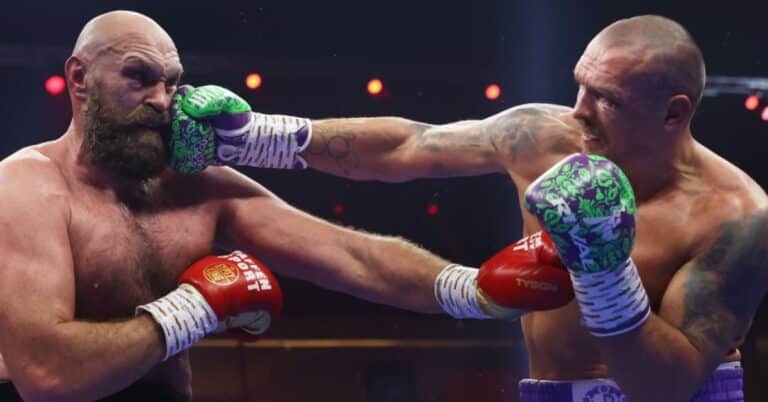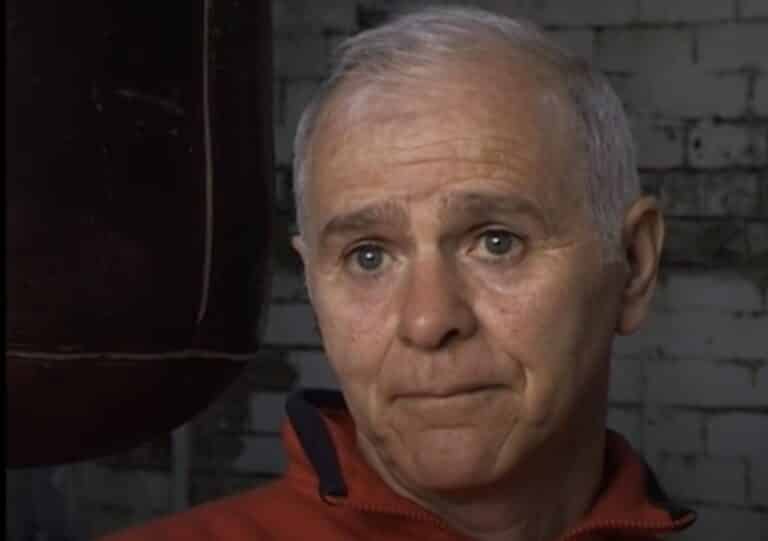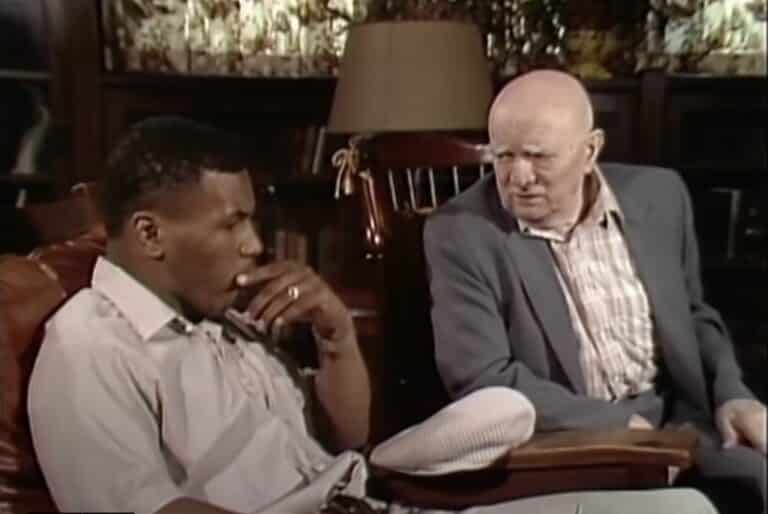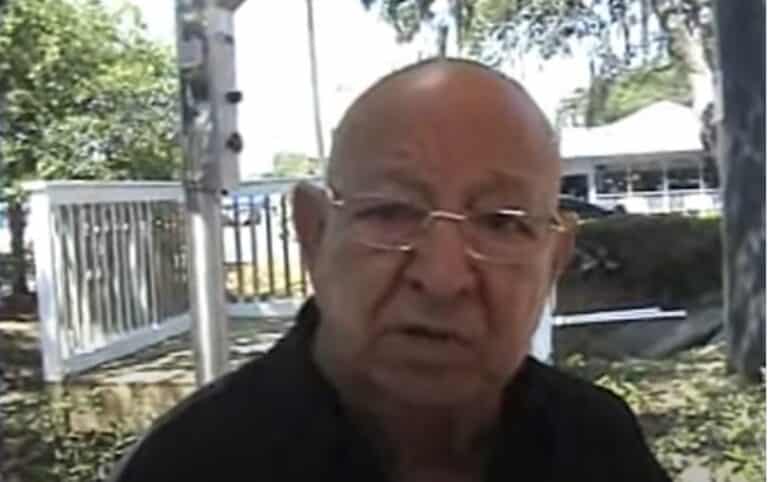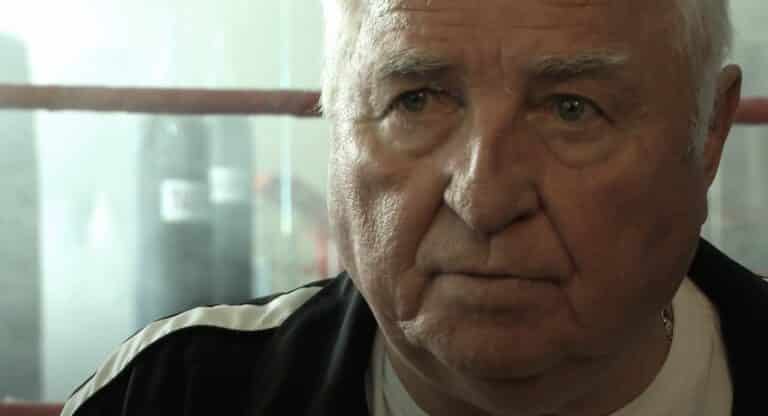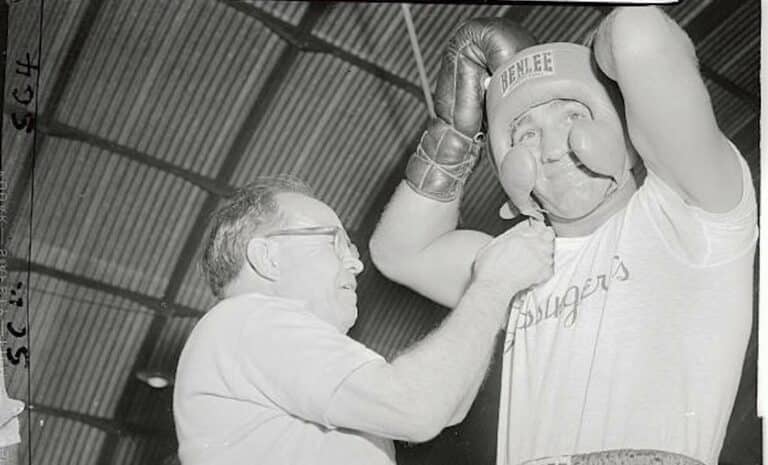Terry Lawless – Boxing Coach Biography
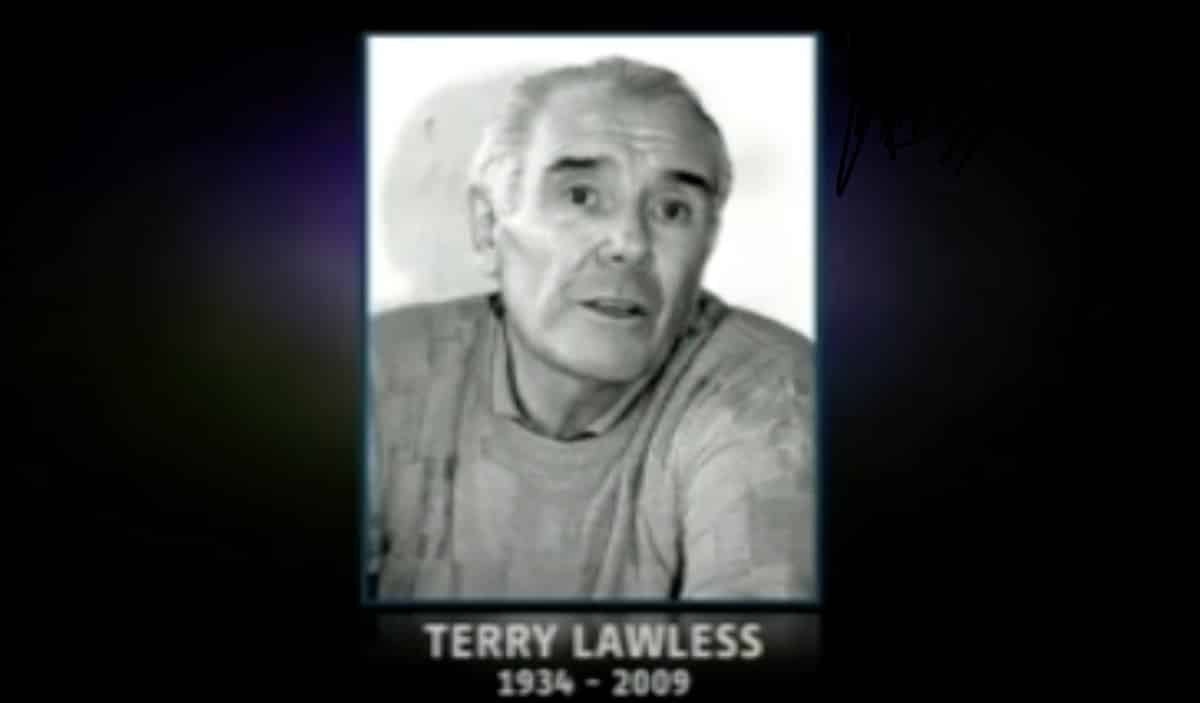
| Date of Birth: | March 29, 1933 |
| Place of Birth: | West Ham, London |
| Gym: | Royal Oak Gym |
| Location: | Canning Town, London |
| Boxing Background: | Terry Lawless began training boxers after leaving the army in 1957 |
| Notable Fighters: | John H Stracey, Jim Watt, Maurice Hope, Frank Bruno |
Terry Lawless’ Boxing Background
Terry Lawless remains arguably the most successful British boxing trainer ever, having coached three fighters – welterweight John H Stracey, flyweight Charlie Magri and light middleweight Maurice Hope – from their pro debuts to becoming world champions. Jim Watt was on the verge of becoming a journeyman when Lawless turned him into the best lightweight in the world, and his fourth world champion. Two others – welterweight Lloyd Honeyghan and heavyweight Frank Bruno – had been with Lawless for most of their careers and learned their craft from the great man, but had switched camps by the time they had won their world titles.
Today, with fighters like Oscar De La Hoya, Miguel Cotto, David Haye and most recently Billy Joe Saunders and Tyson Fury changing trainers several times during their careers, very few coaches get to experience the satisfaction of taking their charge all the way to the pinnacle of the sport.
Terry Lawless Becomes a Trainer
Terry Lawless was born in 1933 in West Ham, a tough area in the East-End of London. His best friend growing up was Sammy McCarthy, who had been an outstanding amateur boxer. As a pro, McCarthy won the British featherweight title and went 28-0 before losing a decision to future world champion Hogan Kid Bassey. McCarthy would also go the distance with world title contenders Ray Famechon and Dave Charnley, and would retire aged just 26 with a very respectable 44-8-1 record. Lawless learned about boxing by assisting McCarthy in his training camps, eventually working the corner in his bouts.
While the perennially amiable Lawless never wished to try boxing himself, he became obsessed with the training and managerial side of the sport. When he finished his National Service with the British Army in 1957 – the same year that Sammy McCarthy retired from the ring, the two opened a boxing gym above the Royal Oak pub in Canning Town, London, with Lawless taking out a boxing mangers license. The Royal Oak Boxing Gym was born.
For three decades beginning with the 1960s, Lawless worked closely with promoters Mickey Duff, Jarvis Astaire, Harry Levene and Mike Barrett, and by the 70s they virtually monopolized British boxing until Frank Warren and Frank Maloney began to shake things up in the 1980s.
John H Stracey
Terry Lawless’s first world champion was welterweight John H Stracey. Stracey was born and raised in the Bethnal Green district of East London, right on the Lawless doorstep. After a stellar amateur career that saw him compete in the Mexico Olympics in 1968, Stracey turner pro in 1969, employing Lawless and his trainer and manager. The clean cut, baby-faced Stracey was an exciting boxer-puncher, and quickly established a following in London, losing just twice in his first 37 fights.
At that time, the welterweight division was dominated by the Cuban Jose Napoles, despite him being well into his 30s and basically a blown-up lightweight. Although just 5’7”, Napoles was such a slick boxer and powerful puncher, he even challenged the mighty Carlos Monzon for the world middleweight title in 1974.
When Stracey got his crack at Napoles in 1975, he was a big underdog. Napoles might have been 35, but the fight was being held in Mexico City, Napoles’ home town since his defection in 1961. The Cuban had held the welterweight title since 1969 – briefly losing it to Billy Backus on a cut eye, then regaining it from Backus seven months later. Napoles defended the welterweight title 12 times.
When Napoles dropped Stracey in the first round, it looked like another easy night for the Cuban was on the cards. However, Stracey survived the round, and in the corner Lawless told his fighter to relax, and that he’d survived the worst. Despite Napoles’ best efforts and the baying Mexican crowd, Stracey gradually took control of the fight, wore down the ageing champion, cut and closed his eyes and scored a stunning sixth round stoppage. At the time, Stracey’s win over Napoles was considered the best ever performance by a British fighter on foreign soil. Suddenly both Stracey and Lawless were big news.
Maurice Hope & Jim Watt
In a major upset, Stracey would lose his welterweight title to Mexico’s little known Carlos Palomino at Wembley in 1976, and it would be another three years before Terry Lawless would get his second world champion – quickly followed by his third.
In March 1979 Maurice Hope – a transplanted Antiguan now living in Hackney – scored an upset ninth round TKO over tough Australian-Italian brawler Rocky Mattioli in San Remo, Italy to win the WBC light middleweight title. The following month, Scotland’s Jim Watt battered Alfredo Pitalua to defeat in twelve rounds in Glasgow to win the vacant WBC lightweight title, recently vacated by Roberto Duran.
Maurice Hope
Hope had been with Lawless since his pro debut in 1973. Hope suffered a major setback in 1975 when he was stopped in eight rounds by Bunny Sterling in a fight for the vacant British middleweight title. Dropping down to the 154 lb class, Hope bounced back the following year and in successive fights picked up the British, European and Commonwealth light middleweight titles. In 1977 Hope was held to a draw in Germany against local boy Eckhard Dagge his first shot at the WBC title.
After defeating Mattioli in 1979, Hope would keep hold of his WBC 154 pound title for two years, making three defenses before losing it to the great Wilfred Benitez on a 12th round knockout in 1981.
Jim Watt
Jim Watt had turned professional in 1968 and after five wins was stopped on a cut eye in his sixth bout. Eight straight victories followed, and Watt took on Willie Reilly for the vacant British lightweight title in 1972, but was stopped in the 10th round, once again on a cut eye. Two years later, and Watt again challenged for the British lightweight title, this time losing on points to fellow Scotsman and former world lightweight champion Ken Buchanan over 15 rounds.
In 1974, Watt was beaten by South African journeyman Anthony Morodi in Johannesburg on a 10 round points decision, and the following year Watt suffered back-to-back defeats to Jonathan Dele in Nigeria and Andre Holyk in France. When Watt was stopped in three rounds by Johnny Claydon in 1976, his once promising career looked over. Watt was 26-7, and had lost four of his last nine bouts.
It was at this point that Watt was approached by Terry Lawless. Lawless believed that despite his record, Watt was potentially the best lightweight in Europe, and while he had certainly underachieved, he had also been the victim of bad luck. In 1976 Watt signed with Lawless, and the following year gained revenge over Johnny Claydon, knocking him out him in the 10th round to win the British lightweight title. In his next fight, Watt avenged his loss to Andre Holyk, stopping the Frenchman in the first round to win the vacant European lightweight title.
Suddenly things were finally going in the right direction for Watt, but he would have to wait two more years before landing his world title shot against Pitalua. As champion, Watt defended his title four times before losing a 15 round decision to the great Alexis Arguello in 1981.
Speaking of his Terry Lawless in his autobiography Watt’s My Name, Jim Watt wrote: “Terry is that rare breed of manager who treats his boxers like sons rather than fighters. He gives 100 per cent and demands the same in return. If it were not for him, I would not have got near to winning a world title.”
In 1983 Charlie Magri stopped Eloncio Mercedes in seven rounds to win the WBC world flyweight crown, the fourth and final fighter that Lawless would guide to world title glory. Magri was a rarity – a European flyweight who fought more like a Mexican – and because of his crowd-pleasing, all-action style Magri topped the bill at the Wembley Arena on multiple occasions, including the night he won his world title.
Frank Bruno
The fighter with whom Terry Lawless was most closely linked, at least from the perspective of the public, was Frank Bruno. Ironically, despite his long association with Lawless, when he finally lifted the world title at the fourth time of asking in 1995, Bruno had switched allegiances to Frank Warren and his team.
In the days before Ricky Hatton, Frank Bruno was the most popular fighter the UK had ever seen. Fight fans are always partial to a heavyweight, and the British public had idolized Henry Cooper, who was occasionally world ranked during the 50s and 60s. Cooper was a brave but limited boxer, cut-prone and undersized, but who famously floored a young Cassius Clay with a left hook in their 1963 title eliminator.
Cooper had lost that fight, plus their 1966 rematch for the world title. In fact Cooper would usually get KO’d by every world class fighter he met, including Zora Folley, Floyd Patterson and Ingemar Johansson. A 21-year giant named Joe Bugner outpointed 37-year old Cooper in 1971, and at 6’4” and 225 lbs in his prime, Bugner had the size and skills to mix with the best, and yet the British public never warmed to him.
However, the British public took to Frank Bruno from day one. First off, Bruno looked sensational. At 6’3” and 220 pound of solid muscle, Bruno might’ve been the most impressive looking heavyweight ever at that time. Secondly, he clearly had world-class punching power. Especially in his early days against limited opposition, Bruno looked like the second coming of Sonny Liston. However his trump card was that when interviewed in the ring, often by Harry Carpenter, Bruno always came across as an extremely humble, amiable and genuinely funny young guy.
After scoring 21-straight KO’s, Bruno’s shortcomings as a fighter were exposed when he was knocked out in the 10th round by James “Bonecrusher” Smith in 1984. Whenever he stepped up in class “Big Frank” would look impressive early on, but would then seemingly run out of gas and become vulnerable late in the fight. In 1986 he challenged Tim Witherspoon for the WBA title, and was knocked out in 11 rounds. Three years later, Bruno was soundly beaten in five rounds by a young Mike Tyson, and in 1993 he began brightly before being taken apart in seven rounds by Lennox Lewis for the WBC heavyweight title.
Bruno and Lawless would part company after the Lewis defeat, and in 1995, Bruno would finally win the WBC heavyweight title when he outpointed the man who had knocked Lennox Lewis out in two rounds the year before, Oliver McCall.
As the 90s drew to a close, Terry Lawless retired to live in Marbella, Spain. In his later years Terry suffered from ill health, and in 2009 he passed away aged 76 following complications after a gall bladder operation. He was survived by his wife Sylvia, his daughter Lorraine and son Steven.
Boxers trained/managed by Terry Lawless
Terry Lawless trained and managed dozens of fighters during his 50-plus years in boxing. Aside from his world champions, Lawless trained such outstanding British fighters as Mark Kaylor, Kirkland Laing, Gary Mason, Horace Notice, John L Gardner and Jimmy Batten. Below is a list of some of the most high profile boxers Terry Lawless trained and managed during his career.
- Ralph Charles (British, European & Commonwealth Welterweight Champion)
- John L. Gardner (British, European & Commonwealth Heavyweight Champion)
- Frank Bruno (WBC Heavyweight champion) – a title won under the guidance of Frank Warren
- Charlie Magri (WBC Flyweight Champion)
- Maurice Hope (WBC Light Middleweight Champion)
- John H. Stracey (WBC Welterweight Champion)
- Jim Watt (WBC Lightweight Champion)
- Joe Calzaghe (WBO, IBF, WBA, WBC & Ring Super Middleweight Champion)
- Jim McDonnell (EBU Featherweight Champion)
- Derek Angol (Commonwealth Cruiserweight Champion)
- Mark Kaylor (British and Commonwealth Middleweight Champion)
- Gary Mason (British and Commonwealth Heavyweight Champion)
- Neville Meade (British and Commonwealth Heavyweight Champion)
- Mo Hussein (Commonwealth Lightweight Champion)
- Jimmy Batten (British Light Middleweight Champion)
- Tony Wilson (British Light-Heavyweight Champion

